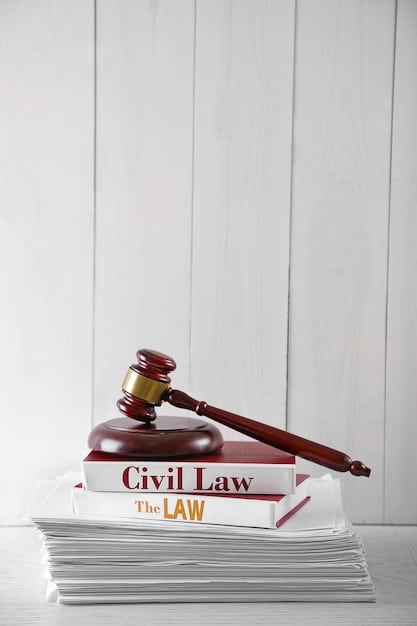US Regulatory Landscape for DAOs: Key Hurdles & Solutions

The US regulatory landscape for Decentralized Autonomous Organizations (DAOs) is still evolving, presenting significant compliance hurdles related to securities laws, taxation, and liability, which can be addressed through proactive legal structuring, robust governance frameworks, and ongoing monitoring of regulatory developments within the next six months.
Navigating the nascent yet complex US regulatory landscape for DAOs: What are the Key Compliance Hurdles and How Can They Be Overcome in the Next 6 Months? requires a proactive and informed approach. DAOs, promising decentralized governance and innovative organizational structures, face a unique set of legal and compliance challenges in the US.
Understanding the Current US Regulatory Climate for DAOs
The current US regulatory environment for DAOs is characterized by uncertainty and a lack of specific legislation tailored to these organizations. Existing laws and regulations, primarily designed for traditional business entities, are often applied to DAOs, creating ambiguity about their legal status and obligations. This section explores the current state of regulation, examining the approaches taken by different regulatory bodies.
Regulatory bodies such as the Securities and Exchange Commission (SEC), the Internal Revenue Service (IRS), and state-level agencies are all scrutinizing DAOs. The core issue lies in determining whether DAOs fit into existing legal frameworks or require new, specific regulations.
SEC Scrutiny and Securities Laws
The SEC’s primary concern is whether DAOs are issuing or trading securities without proper registration. If a DAO’s tokens are deemed securities, the DAO must comply with stringent registration and disclosure requirements. This determination hinges on whether the tokens meet the definition of a security under the Howey Test, which assesses whether there is an investment of money in a common enterprise with the expectation of profit derived from the efforts of others.
- Application of the Howey Test: DAOs must carefully evaluate whether their token offerings fall under the Howey Test.
- Registration Requirements: If deemed securities, DAOs need to register with the SEC or seek an exemption.
- Enforcement Actions: DAOs should be aware of past SEC enforcement actions against crypto entities and apply those lessons.
Understanding and complying with securities laws is critical for DAOs to avoid legal repercussions. The SEC’s stance on digital assets and DAOs is evolving, so staying informed is crucial.

Taxation Issues and IRS Guidelines
Taxation is another significant hurdle for DAOs. The IRS has not issued specific guidance for DAOs, leaving them to navigate complex tax laws designed for traditional business structures. Determining the tax obligations of a DAO and its members can be challenging due to the decentralized nature of these organizations.
Key considerations include determining the taxable status of the DAO (e.g., partnership, corporation, or other entity) and understanding the tax implications of token distributions and governance activities.
- Entity Classification: DAOs must determine their appropriate tax classification under US law.
- Taxable Events: DAOs need to identify and properly report taxable events, such as token distributions and revenue generation.
- Reporting Requirements: DAOs must comply with IRS reporting requirements, which may vary based on their classification.
Navigating the tax landscape requires careful planning and compliance to avoid potential audits and penalties. Consulting with tax professionals experienced in crypto and DAOs is highly recommended.
In conclusion, the US regulatory climate for DAOs is complex and uncertain. DAOs must proactively address these challenges by carefully evaluating their activities, seeking legal and tax advice, and staying informed about regulatory developments.
Key Compliance Hurdles for DAOs in the US
DAOs face several critical compliance hurdles that can impede their operations and expose them to legal risks. These hurdles stem from the decentralized and novel nature of DAOs, which often do not fit neatly into existing legal frameworks. Understanding these challenges is the first step toward overcoming them.
The primary compliance hurdles include legal entity structuring, regulatory compliance, and governance and operational challenges.
Legal Entity Structuring
One of the most significant challenges for DAOs is determining the appropriate legal structure. Unlike traditional businesses, DAOs lack a clear legal definition, making it difficult to choose a structure that provides legal protection and clarity. Options include forming as a limited liability company (LLC), a cooperative, or remaining unincorporated, each with its own implications.
Choosing the right legal structure is crucial for liability protection, taxation, and regulatory compliance.
- Liability Protection: Selecting a structure that shields members from personal liability is essential.
- Tax Implications: The chosen structure will affect the DAO’s tax obligations and reporting requirements.
- Regulatory Compliance: Different structures may be subject to varying levels of regulatory scrutiny.
Navigating Regulatory Compliance
Regulatory compliance extends beyond securities and taxation. DAOs must also consider anti-money laundering (AML) laws, consumer protection regulations, and state-specific requirements. Compliance can be particularly challenging due to the decentralized and often pseudonymous nature of DAO participants.
AML compliance is particularly important, as DAOs can be used for illicit activities if proper controls are not in place.
- AML Obligations: DAOs must implement AML programs to prevent money laundering and terrorist financing.
- Consumer Protection: DAOs need to comply with consumer protection laws, ensuring fair and transparent practices.
- State Regulations: DAOs must adhere to state-specific regulations, which can vary significantly.

Governance and Operational Challenges
Effective governance is vital for DAOs to ensure accountability, transparency, and compliance. However, the decentralized nature of DAOs can make governance challenging. Clear rules, voting mechanisms, and decision-making processes are essential for managing the DAO effectively.
Operational challenges also include managing smart contracts, securing DAO assets, and ensuring the integrity of DAO operations.
Good governance is fundamental for DAOs to achieve their goals and maintain trust among members.
- Voting Mechanisms: DAOs should establish clear and secure voting mechanisms for decision-making.
- Smart Contract Security: DAOs must ensure the security and integrity of their smart contracts to prevent vulnerabilities.
- Transparency: DAOs should maintain transparency in their operations, providing members with access to relevant information.
In summary, DAOs face significant compliance hurdles related to legal entity structuring, regulatory compliance, and governance and operations. Proactive measures are needed to address these challenges and ensure long-term sustainability.
Overcoming Compliance Hurdles: Strategies for DAOs
To successfully navigate the complex regulatory landscape, DAOs need to adopt proactive strategies that address the key compliance hurdles. These strategies involve careful planning, implementation of best practices, and ongoing monitoring of regulatory developments. This section outlines practical steps DAOs can take to enhance their compliance efforts.
Key strategies include establishing a robust legal framework, implementing effective governance mechanisms, and leveraging technology for compliance.
Establishing a Robust Legal Framework
DAOs should prioritize establishing a clear legal framework that provides liability protection, clarifies tax obligations, and facilitates regulatory compliance. This involves choosing an appropriate legal structure, such as an LLC or cooperative, and documenting the DAO’s legal status and activities.
A well-defined legal framework provides a solid foundation for DAO operations and helps mitigate legal risks.
Here are some key steps:
- Legal Consultation: Seek advice from experienced legal professionals to determine the best legal structure for the DAO.
- Documentation: Document the DAO’s legal status, purpose, and activities in a formal agreement.
- Compliance Review: Regularly review the legal framework to ensure it remains compliant with changing regulations.
Implementing Effective Governance Mechanisms
Strong governance is essential for DAOs to ensure accountability, transparency, and compliance. This involves establishing clear rules, voting mechanisms, and decision-making processes that are transparent and accessible to all members. Effective governance also includes implementing internal controls to prevent fraud and mismanagement.
Good governance fosters trust and confidence among DAO members and stakeholders.
Governance best practices include:
- Transparent Voting: Implement a secure and transparent voting system that allows members to participate in decision-making.
- Internal Controls: Establish internal controls to prevent fraud, ensure accountability, and safeguard DAO assets.
- Regular Audits: Conduct regular audits of DAO operations to identify and address any issues or weaknesses.
Leveraging Technology for Compliance
Technology can play a crucial role in helping DAOs comply with regulations. Smart contracts can be used to automate compliance processes, such as AML screening and reporting. Blockchain technology can provide transparency and auditability, making it easier to demonstrate compliance to regulators.
Technology can streamline compliance efforts and reduce the risk of errors and omissions.
Examples of technology-driven compliance include:
- AML Screening Tools: Use AML screening tools to identify and flag suspicious transactions.
- Automated Reporting: Automate reporting processes to ensure timely and accurate compliance with regulatory requirements.
- Blockchain Audit Trails: Utilize blockchain technology to create transparent and auditable records of DAO activities.
By adopting these strategies, DAOs can significantly improve their compliance posture and mitigate legal risks. Proactive compliance efforts are essential for ensuring the long-term sustainability and success of DAOs in the US.
Anticipating Regulatory Changes in the Next 6 Months
The regulatory landscape for DAOs is rapidly evolving, and DAOs need to stay informed about potential changes that may impact their operations. This involves monitoring regulatory developments, engaging with policymakers, and adapting compliance strategies accordingly. This section explores how DAOs can anticipate and prepare for regulatory changes in the next six months.
Key steps include monitoring regulatory developments, engaging with policymakers, and conducting regular risk assessments.
Monitoring Regulatory Developments
Staying informed about regulatory developments is crucial for DAOs to remain compliant. This involves tracking legislative and regulatory activity at the federal and state levels, as well as monitoring enforcement actions and guidance issued by regulatory bodies like the SEC and IRS.
Regular monitoring allows DAOs to anticipate changes and adjust their compliance strategies proactively.
Here’s how to stay informed:
- Follow Regulatory Agencies: Monitor the websites and publications of regulatory agencies for updates and guidance.
- Join Industry Associations: Participate in industry associations and forums to stay abreast of regulatory developments.
- Consult Legal Experts: Engage with legal experts who specialize in crypto and DAO regulations.
Engaging with Policymakers
DAOs can play an active role in shaping the regulatory landscape by engaging with policymakers and advocating for clear and sensible regulations. This involves educating policymakers about DAOs, participating in public consultations, and providing feedback on proposed regulations.
Engaging with policymakers can help ensure that regulations are tailored to the unique characteristics of DAOs.
Effective engagement strategies include:
- Educate Policymakers: Provide policymakers with information about DAOs, their benefits, and their regulatory needs.
- Participate in Consultations: Participate in public consultations and provide feedback on proposed regulations.
- Advocate for Clarity: Advocate for clear and consistent regulations that promote innovation and protect consumers.
Conducting Regular Risk Assessments
Regular risk assessments are essential for DAOs to identify and mitigate potential compliance risks. This involves evaluating the DAO’s activities, policies, and procedures to determine areas of vulnerability and implementing measures to address those weaknesses.
Risk assessments help DAOs proactively manage compliance risks and prevent regulatory violations.
Key elements of a risk assessment include:
- Identify Risks: Identify potential compliance risks related to securities laws, taxation, AML regulations, and other applicable laws.
- Assess Likelihood and Impact: Assess the likelihood and potential impact of each risk.
- Implement Mitigation Measures: Implement measures to mitigate identified risks, such as enhanced internal controls and compliance training.
By proactively monitoring regulatory developments, engaging with policymakers, and conducting regular risk assessments, DAOs can better anticipate and prepare for regulatory changes in the next six months. This proactive approach is essential for navigating the evolving regulatory landscape and ensuring long-term compliance.
Best Practices for DAO Compliance in the US
In addition to proactive strategies, DAOs should adopt best practices that enhance their compliance efforts and promote responsible governance. These best practices cover various aspects of DAO operations, from legal structuring to risk management. This section outlines key best practices for DAO compliance in the US.
These best practices encompass legal and regulatory compliance, governance and operational practices, and risk management strategies.
Legal and Regulatory Compliance
Adhering to legal and regulatory requirements is fundamental for DAO compliance. This involves understanding and complying with securities laws, tax regulations, AML obligations, and other applicable laws. DAOs should implement policies and procedures to ensure compliance and regularly review their compliance framework to adapt to changing regulations.
Robust legal and regulatory compliance helps DAOs avoid legal risks and maintain their legitimacy.
Key practices include:
- Compliance Policies: Develop and implement comprehensive compliance policies that address all applicable legal and regulatory requirements.
- Regular Training: Provide regular compliance training to DAO members to ensure they understand their obligations.
- Independent Audits: Conduct independent audits of DAO operations to verify compliance with legal and regulatory requirements.
Governance and Operational Practices
Effective governance and operational practices are essential for promoting transparency, accountability, and responsible decision-making within the DAO. This involves establishing clear rules, voting mechanisms, and decision-making processes that are accessible to all members. DAOs should also implement internal controls to prevent fraud and mismanagement.
Strong governance and operational practices foster trust and confidence among DAO members and stakeholders.
Best practices in governance include:
- Transparent Operations: Maintain transparency in all DAO operations, providing members with access to relevant information.
- Inclusive Decision-Making: Promote inclusive decision-making processes that allow all members to participate and have their voices heard.
- Accountability Mechanisms: Implement accountability mechanisms to hold DAO members responsible for their actions.
Risk Management Strategies
Effective risk management is crucial for DAOs to identify and mitigate potential compliance risks. This involves conducting regular risk assessments, implementing mitigation measures, and monitoring the effectiveness of those measures. DAOs should also develop contingency plans to address potential risks and emergencies.
Proactive risk management helps DAOs protect their assets, maintain their reputation, and ensure their long-term sustainability.
Key elements of a risk management strategy include:
- Risk Identification: Identify potential risks related to compliance, security, operations, and finances.
- Mitigation Measures: Implement measures to mitigate identified risks, such as enhanced security protocols and insurance coverage.
- Monitoring and Review: Regularly monitor and review the effectiveness of risk management measures and adapt them as needed.
Adopting these best practices can significantly enhance DAO compliance in the US. By prioritizing legal and regulatory compliance, implementing effective governance and operational practices, and adopting proactive risk management strategies, DAOs can navigate the complex regulatory landscape and ensure their long-term success.
Case Studies: How DAOs are Addressing US Regulations
Examining real-world examples of how DAOs are approaching US regulations can provide valuable insights and practical guidance. Several DAOs have taken proactive steps to address compliance challenges and navigate the regulatory landscape. This section presents case studies of DAOs that demonstrate best practices and innovative approaches to compliance.
These case studies highlight different strategies and approaches to compliance, offering lessons for other DAOs.
Case Study 1: DAOs Forming Legally
One notable approach is to form a legal entity, such as an LLC, to provide a clear legal framework for the DAO. This structure can help provide liability protection for members and simplify compliance with tax and regulatory requirements.
Key takeaways from this case study include:
- Legal Clarity: Forming a legal entity provides clarity regarding the DAO’s legal status and obligations.
- Liability Protection: Members are shielded from personal liability, reducing their individual risk.
- Simplified Compliance: Compliance with tax and regulatory requirements is simplified through the established legal structure.
Case Study 2: DAOs Using KYC/AML Practices
Adopting KYC/AML practices is essential for DAOs to comply with anti-money laundering regulations. This involves implementing procedures to verify the identity of DAO members and monitor transactions for suspicious activity.
Key insights from this case study include:
- Regulatory Compliance: KYC/AML practices ensure compliance with anti-money laundering regulations.
- Risk Mitigation: The risk of illicit activities is reduced through identity verification and transaction monitoring.
- Enhanced Trust: Trust and confidence among DAO members and stakeholders are enhanced through transparency.
Case Study 3: DAOs Focusing on Transparency
Some DAOs are emphasizing transparency in their operations to build trust and demonstrate accountability. This involves providing members with access to financial information, decision-making processes, and other relevant data.
Lessons learned from this case study include:
- Enhanced Trust: Transparency builds trust and confidence among DAO members and stakeholders.
- Accountability: Members are held accountable for their actions through open communication and access to information.
- Community Engagement: Community engagement is fostered through transparency and participation in decision-making.
These case studies illustrate how DAOs are addressing US regulations through various strategies and best practices. By forming legal entities, adopting KYC/AML practices, and focusing on transparency, DAOs can navigate the regulatory landscape and ensure their long-term sustainability.
Conclusion
In conclusion this emerging era of decentralization, the US regulatory landscape for DAOs: What are the Key Compliance Hurdles and How Can They Be Overcome in the Next 6 Months? is complex. DAOs must take proactive steps, from forming solid legal frameworks to implementing transparent governance, staying compliant and thriving in the ever-shifting regulatory terrain.
| Key Aspect | Brief Description |
|---|---|
| ⚖️ Legal Structuring | Choosing the right legal structure to ensure liability protection and tax efficiency. |
| 🛡️ Regulatory Compliance | Complying with securities, tax, and AML regulations to avoid legal issues. |
| 🏛️ Governance Practices | Establishing transparent and inclusive decision-making processes. |
| 💡 Risk Management | Identifying and mitigating potential compliance and operational risks proactively. |
Frequently Asked Questions (FAQ)
▼
A DAO is a Decentralized Autonomous Organization that operates through smart contracts on a blockchain. In the US, DAOs face regulatory uncertainty as existing laws may not directly apply, leading to challenges in determining their legal status and compliance requirements.
▼
Key compliance hurdles include legal entity structuring, navigating securities laws, taxation, and anti-money laundering (AML) regulations. DAOs must decide how to structure themselves legally and ensure compliance with various financial and operational regulations.
▼
DAOs can overcome compliance challenges by establishing a clear legal framework, implementing effective governance mechanisms, and leveraging technology to automate compliance processes. This includes seeking legal advice and staying informed about regulatory developments.
▼
The SEC scrutinizes DAOs to determine if their tokens are securities. If deemed securities, DAOs must comply with registration and disclosure requirements. The Howey Test is often used to assess whether a DAO’s token offering meets the definition of a security.
▼
DAOs should monitor regulatory developments, engage with policymakers, and conduct regular risk assessments to prepare for upcoming changes. Staying informed and adapting compliance strategies proactively is essential for navigating the evolving regulatory landscape.





